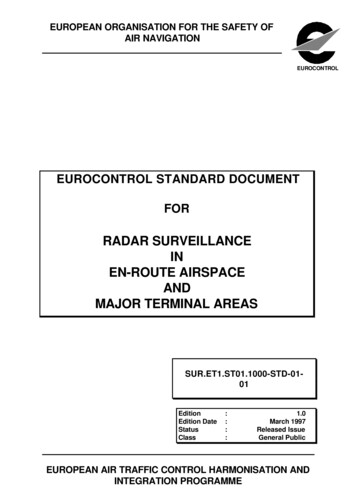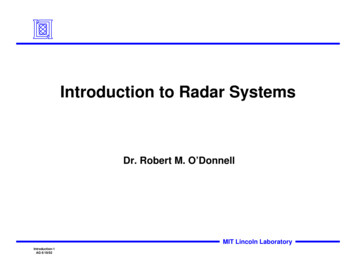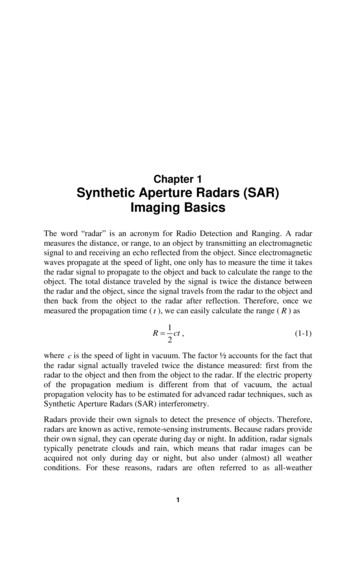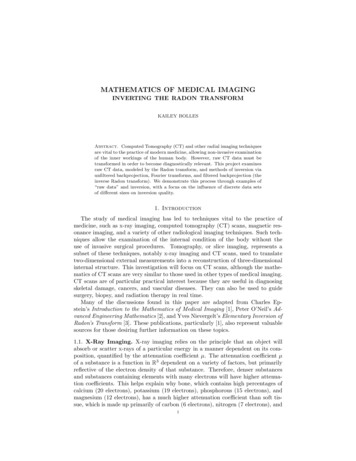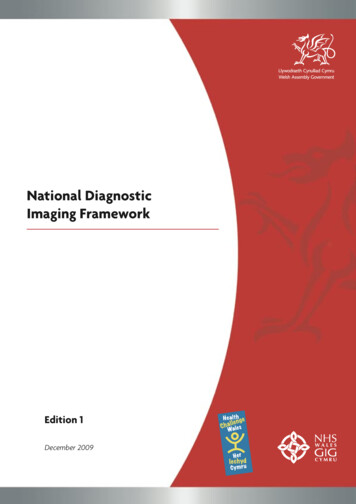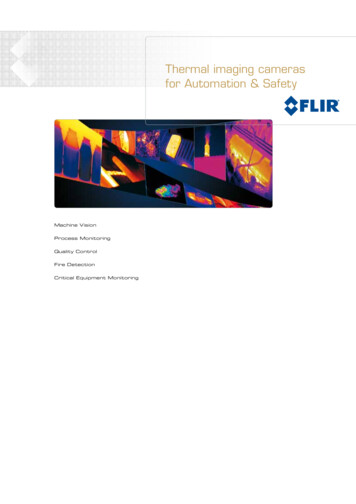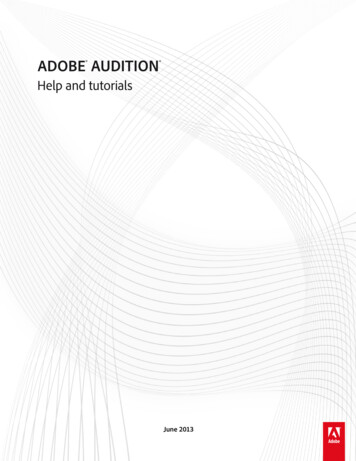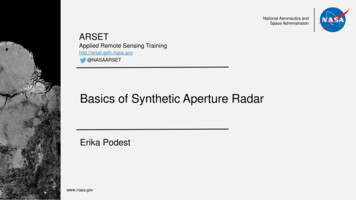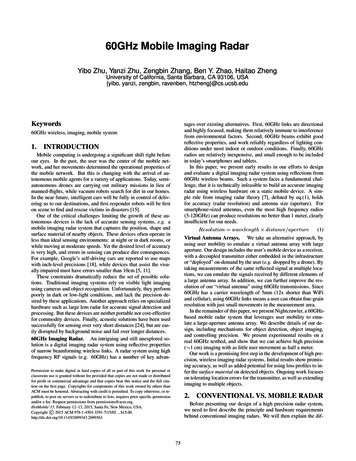
Transcription
60GHz Mobile Imaging RadarYibo Zhu, Yanzi Zhu, Zengbin Zhang, Ben Y. Zhao, Haitao ZhengUniversity of California, Santa Barbara, CA 93106, USA{yibo, yanzi, zengbin, ravenben, htzheng}@cs.ucsb.eduKeywordstages over existing alternatives. First, 60GHz links are directionaland highly focused, making them relatively immune to interferencefrom environmental factors. Second, 60GHz beams exhibit goodreflective properties, and work reliably regardless of lighting conditions under most indoor or outdoor conditions. Finally, 60GHzradios are relatively inexpensive, and small enough to be includedin today’s smartphones and tablets.In this paper, we present early results in our efforts to designand evaluate a digital imaging radar system using reflections from60GHz wireless beams. Such a system faces a fundamental challenge, that it is technically infeasible to build an accurate imagingradar using wireless hardware on a static mobile device. A simple rule from imaging radar theory [7], defined by eq.(1), holdsfor accuracy (radar resolution) and antenna size (aperture). Forsmartphone-sized antennas, even the most high frequency radios(5-120GHz) can produce resolutions no better than 1 meter, clearlyinsufficient for our needs.60GHz wireless, imaging, mobile system1.INTRODUCTIONMobile computing is undergoing a significant shift right beforeour eyes. In the past, the user was the center of the mobile network, and her movements determined the operational properties ofthe mobile network. But this is changing with the arrival of autonomous mobile agents for a variety of applications. Today, semiautonomous drones are carrying out military missions in lieu ofmanned-flights, while vacuum robots search for dirt in our homes.In the near future, intelligent cars will be fully in control of delivering us to our destinations, and first responder robots will be firston scene to find and rescue victims in disasters [15].One of the critical challenges limiting the growth of these autonomous devices is the lack of accurate sensing systems, e.g. amobile imaging radar system that captures the position, shape andsurface material of nearby objects. These devices often operate inless than ideal sensing environments: at night or in dark rooms, orwhile moving at moderate speeds. Yet the desired level of accuracyis very high, and errors in sensing can produce dire consequences.For example, Google’s self-driving cars are reported to use mapswith inch-level precisions [18], while devices that assist the visually impaired must have errors smaller than 10cm [5, 11].These constraints dramatically reduce the set of possible solutions. Traditional imaging systems rely on visible light imagingusing cameras and object recognition. Unfortunately, they performpoorly in dark or low-light conditions, and lack the precision desired by these applications. Another approach relies on specializedhardware such as large lens radar for accurate signal detection andprocessing. But these devices are neither portable nor cost-effectivefor commodity devices. Finally, acoustic solutions have been usedsuccessfully for sensing over very short distances [24], but are easily disrupted by background noise and fail over longer distances.60GHz Imaging Radar. An intriguing and still unexplored solution is a digital imaging radar system using reflective propertiesof narrow beamforming wireless links. A radar system using highfrequency RF signals (e.g. 60GHz) has a number of key advan-Resolution wavelength distance/aperture(1)Virtual Antenna Arrays. We take an alternative approach, byusing user mobility to emulate a virtual antenna array with largeaperture. Our design includes the user’s mobile device as a receiver,with a decoupled transmitter either embedded in the infrastructureor “deployed” on-demand by the user (e.g. dropped by a drone). Bytaking measurements of the same reflected signal at multiple locations, we can emulate the signals received by different elements ofa large antenna array. In addition, we can further improve the resolution of our “virtual antenna” using 60GHz transmissions. Since60GHz has a carrier wavelength of 5mm (12x shorter than WiFiand cellular), using 60GHz links means a user can obtain fine-grainresolution with just small movements in the measurement area.In the remainder of this paper, we present Nightcrawler, a 60GHzbased mobile radar system that leverages user mobility to emulate a large-aperture antenna array. We describe details of our design, including mechanisms for object detection, object imaging,and controlling precision. We present experimental results on areal 60GHz testbed, and show that we can achieve high precision( 1 cm) imaging with as little user movement as half a meter.Our work is a promising first step in the development of high precision, wireless imaging radar systems. Initial results show promising accuracy, as well as added potential for using loss profiles to infer the surface material on detected objects. Ongoing work focuseson tolerating location errors for the transmitter, as well as extendingimaging to multiple objects.Permission to make digital or hard copies of all or part of this work for personal orclassroom use is granted without fee provided that copies are not made or distributedfor profit or commercial advantage and that copies bear this notice and the full citation on the first page. Copyrights for components of this work owned by others thanACM must be honored. Abstracting with credit is permitted. To copy otherwise, or republish, to post on servers or to redistribute to lists, requires prior specific permissionand/or a fee. Request permissions from permissions@acm.org.HotMobile’15, February 12–13, 2015, Santa Fe, New Mexico, USA.Copyright c 2015 ACM 978-1-4503-3391-7/15/02 . 15.00.http://dx.doi.org/10.1145/2699343.2699363.2. CONVENTIONAL VS. MOBILE RADARBefore presenting our design of a high precision radar system,we need to first describe the principle and hardware requirementsbehind conventional imaging radars. We will then explain the dif-75
60GHz has a carrier wavelength of 5mm, more than 12x shorterthan WiFi and cellular. According to eq. (1), the required antenna aperture for 60GHz is at least 12x smaller than WiFi/cellularfor the same imaging resolution.ferences between personal mobile radar systems and conventionalimaging radar systems, and the challenges that arise as a result.Traditional Radar Imaging. Imaging radars detect the presence,position, and shape of an object by emitting directional RF signalsand capturing/analyzing the portion of signal reflected by the object. Specifically, a radar estimates its distance to the object bymeasuring the round trip time of the reflected signal, either directlyusing a highly precise clock, or indirectly by transmitting frequencymodulation (FM) pulses and measuring the frequency offset of thereflected signal [7]. The radar also uses highly directional RF signals to “scan” the object. Because the signals reflected from the object and its nearby spaces carry different signal strengths, the radarcan identify the object’s position and shape with high precision. Finally, high-end radars can identify object material using dispersionanalysis, where they emit RF signals at various carrier frequenciesand collect reflection results. Since different materials have different reflection profiles across frequencies, one can estimate materialtype by analyzing reflection results.Overall, traditional imaging radars have strong requirements onradio hardware, e.g. they require specialized FM circuits and highlydirectional dish antennas. These are easily met for applicationswhere radar size and cost are not an issue, such as military radarsystems or radio telescopes for use in astronomy.Why Mobile Radar Imaging is Hard. Our goal in this paper isto design radar imaging systems to enable commodity mobile devices to recognize their surrounding environments. This is highlychallenging, due to tight constraints on radio size, functionality andcost. First, the small form factor of mobile devices puts a hardlimit on both antenna size (which determines aperture) and signaldirectionality. As shown by the Radar Theory in eq. (1), the smallantenna size severely limits the maximum imaging resolution. Forsmartphone-sized antennas (2.5cm aperture), the maximum imaging resolution for an object of 10m away is 1m using 120GHztransmissions or 24m at 5GHz. Second, today’s mobile devices arenot equipped with FM pulse circuits, which are required for distance estimation by traditional radar imaging. Adding such circuitswould significantly increase costs for budget-conscious mobile radio chipsets. Similar cost constraints prohibit the inclusion of hardware solutions to perform dispersion analysis for material detectionor clock-based distance computation1 .3. 60GHz’s short wavelength also makes its propagation much morestable/predictable. With minimum multi-path effects, signal strengthremains stable over time, and is strongly correlated with propagation distance. This increases the robustness of our imagingdesign. For example, our imaging system can easily distinguishbetween a line-of-sight signal and a reflected signal that traveledover a longer distance, and use this fact to detect the presence ofobjects in local neighborhood. The object reflection profile is more stable at 60GHz. For example, the signal reflection loss has strong correlation with theobject material. This enables Nightcrawler to narrow down thematerial type using signal strength measurements.Mobility enabled virtual antenna array. Nightcrawler exploitsthe fact that as a user moves, her mobile device can take signalmeasurements at multiple locations, emulating a virtual antenna array whose antenna aperture is significantly larger3 . This enableshighly directional signal reception by a mobile device similar tothose required by conventional radar imaging, and overcomes thelimitation imposed by the size of mobile devices.User mobility also increases the system’s detection range andability to detect surface curvature of objects. Surfaces with different curvatures reflect the signal to different directions in the space.Measuring reflections from different locations helps the radar capture the curvature of each of the object’s multiple faces.Decoupling transmitter and receiver. Given the small size ofmobile devices, any mobile radar system cannot rely on just a singledevice to serve as both transmitter and receiver. Our design fora mobile radar system involves the primary mobile device, whichacts as a receiver, and a decoupled transmitter, which can be eitherinfrastructure-based, or a separate mobile device.For example, an imaging system to assist the visually impairedmay include an app on the user’s smartphone, which coordinateswith one or more transmitters embedded in the walls or ceiling. Incontrast, an autonomous device (e.g. first responder robots) can“deploy” a secondary transmitter device.Once deployed (or periodically for infrastructure devices), thetransmitter (TX) sends 60GHz beacons that reflect off of nearby objects4 . Each beacon includes the angle of transmission, and if possible the transmitter’s location. Users hold a mobile device equippedwith a 60GHz receiver (RX), and move in pedestrian speeds. EachRX periodically scans5 and records signal strengths for beaconsacross different directions. Nightcrawler processes these data onthe fly to identify, locate and image objects in the local area.60GHZ IMAGING RADARTo overcome challenges of size and cost in mobile devices, wepropose to leverage human mobility to extend the reach of a singlemobile antenna. We proposes Nightcrawler, a mobile radar imaging system using commodity 60GHz networking chipsets2 . Usingcommodity chipsets, Nightcrawler performs object imaging usingjust signal measurements, and improves imaging resolution far beyond the theoretical limit defined by eq. (1). It achieves this byleveraging user mobility and unique RF propagation properties of60GHz transmissions. This section describes our core ideas andsets the context for details of our prototype in §4.Leveraging 60GHz. Today’s mobile devices are equipped withmultiple wireless interfaces, e.g. cellular, WiFi, Bluetooth, and60GHz radio [22]. We implement Nightcrawler using 60GHz radios because its unique propagation properties present three significant advantages for our application.4. Nightcrawler: A FIRST LOOKWe now describe our initial design. Seen in Figure 1, a primarydevice (RX) and decoupled transmitter (TX) start from “sensing”mode to identify the presence of any object. Upon detection, theyswitch to “imaging” mode to build a physical map of the object(s).We assume that the RX knows its relative position from the TX.4.1 Object SensingNightcrawler devices sense objects using the bootstrapping procedure defined by IEEE 802.11ad, the standard for 60GHz trans3Aperture of virtual array is equal to distance traveled by the user.The beacon transmitters rotate their beam direction periodicallyto cover multiple objects or larger objects.5Today’s 60GHz antenna arrays can adjust beam direction every50us. So each RX can scan multiple directions in real time.1To measure round trip time accurately, i.e. with 1cm accuracy, theclock precision must be at least 0.033ns, which is extremely hardto realize on smartphones and laptops.2Low-cost 60GHz chipsets are available today on the mass market,e.g. WiloCity chipsets cost 37.5 and has a 23m range [22, 26].476
Direction 1Coarse position, distance2ObjectObject3TXInitial Position Detection5ReflectionTXUser movementRX1 RX2 RX3AoA detectionUse direction 3Imaging measurementDataObjectimageMaterial DetectionDetect boundariesPosition,shapeForm narrow beamson the objectEmulatesynthetic array RX1RX (User)Object SensingFine-grained ImagingCoarseposition,distanceTX4MaterialPosition, shapeLookup in materialdatabaseRX2RX3Compute reflectionloss and incident angleImaging computationFigure 1: The high-level overview of the Nightcrawler radar imaging system.ment location, Nightcrawler derives the AoA as the strongest receive beam direction. Since the TX embeds the beam direction ineach beacon signal, the RX can estimate the object position as theintersection of the TX beam direction and the AoA.Ideally, Nightcrawler should identify object position reliably frommeasurements at a single location. In practice, AoA detection canbe noisy due to hardware artifacts, imperfect reflection from uneven surface, and the fact that each TX beam is not narrow enough.For example, our testbed results show that when using a TX beamof 10 beamwidth, the noise in AoA estimation can lead to up to1m position error when the object is 6m away from the RX.Nightcrawler overcomes this challenge by performing “majority vote” on measurements collected at multiple locations. Specifically, Nightcrawler considers data from N locations, each producing an estimated object position. It then identifies a cluster of[N/2] 1 positions with the minimum MSE among themselves,and computes the center of the cluster, i.e. the position with theminimum MSE to all the positions, as the final object position. Thissolution, while simple, can effectively improve the positioning accuracy. Our testbed results in §5 show that with N 9, the positionerror in the above example reduces from 1m to below 10cm.missions [2]. The TX operates in the directional mode, steers itsbeam to different directions, e.g. in sectors of 3 in width, and embeds the direction in the signal. Operating in the omni-directionalmode, the RX measures RSS and reports a list of TX beam directions where RSS exceeds the noise level6 . The RX then identifiesand removes from the list the set of TX beam directions whosetransmissions did not experience any reflection. The remaining listof directions, if any, are those where the transmission was reflected,implying that at least one object exists in the local neighborhood.To identify TX beam directions that did not experience reflection, the RX uses simple geometry to locate a set of candidate LoSbeam directions based on the relative position of TX and RX andtheir antenna radiation patterns. It then validates each candidate direction by comparing its RSS to the model-predicted value withoutany reflection. If a direction gets (partially) reflected, its RSS willbe lower than the model-predicted value due to longer propagationpath and possible reflection loss.4.2 Object ImagingAfter detecting the presence of objects, Nightcrawler devices enter the “imaging” mode. Intuitively, Nightcrawler should use theabove collection of “reflected TX beam directions” to drive imaging. That is, the TX focuses its transmissions on these directions(by rotating its beam repeatedly across them in a round-robin fashion) while the RX locates and images object(s) in each direction.To improve imaging efficiency, it is desirable to identify a subset ofthe directions that cover all the potential objects. In our preliminarywork, we leave this optimization to future work and simply assumethat the reflected direction set only has a single direction.With this in mind, our following description on Nightcrawler assumes that during imaging, the TX focuses its beam on the targeteddirection and transmits the same beacon signal repeatedly. The RX,while moving, operates in the directional mode and steers its beamaround to capture signals at each measurement location. This isdone using the antenna alignment procedure defined by 802.11ad– the RX steers its beam across various directions and reports thedirection with the strongest RSS. Once the movement distance issufficient, the RX executes the imaging algorithm on the measurement data to locate and image the object.The Nightcrawler imaging algorithm includes three steps: (1)coarse position estimation, (2) fine-grained imaging, and (3) material detection. We now describe them in more details.4.2.2 Fine-grained ImagingThis step derives the precise position and shape of the objectby implementing a large aperture virtual antenna array from aggregating signal measurements at different locations. Specifically,Nightcrawler identifies the object shape by detecting its boundariesas well as surface curvature, i.e. flat, convex or concave.Detecting Object Boundaries. Inspired by airplane radars thatimplement synthetic aperture radar (SAR) to detect object size [7],Nightcrawler uses a small and moving RX antenna to emulate elements of a large array. The resulting synthetic array has a verynarrow beam pattern and can identify signals at fine-grained directions. Thus the RX can observe a sharp decrease in RSS along theobject boundaries, and locate these boundaries with errors boundedby the (very narrow) beamwidth of the synthetic array.A key component of our design is how to aggregate measuredsignals across locations to emulate the large array. This is doneby “reverse-engineering” the process of a phased array focusing itsbeam. Specifically, let the estimated object position in the previousstep be X0 . Nightcrawler picks a set of reflection “focus points”near X0 as the potential boundary positions. Given a target imageresolution r, any two neighboring focus points should be within adistance of r/2. For each focus point, Nightcrawler applies a focusprocess to derive the RSS of signals reflected by the small area ofwidth r around the given focus point. This is done by first shiftingthe phase of signals collected at each measurement location by itsdistance to the focus point and then summing up all the signalsacross locations. After applying this on all the focus points, theRX obtains a reflected RSS map along the object itself. The objectboundaries are the two focus points where the RSS drops sharply.4.2.1 Coarse Position EstimationNightcrawler first estimates the object’s relative position and distance to the RX. This narrows down the search space for the nextstep, which applies a more sophisticated approach to perform detailed imaging. The RX estimates the object position by extractingthe angle of arrival (AoA) of the beacon signal. At each measure6This step is slightly different from 802.11ad where the RX onlyreports the direction with the strongest RSS.77
Note that Nightcrawler emulates the large array without synchronizing TX and RX. This is because all the measurements are doneby a single receiver RX. As long as the TX sends the same beaconsignal (per TX beam direction) during imaging, the RX can eliminate any phase offset caused by differences in measurement time.Inferring Surface Curvature. Nightcrawler recognizes the object’s surface curvature based on a simple intuition – signals reflected by a flat surface display a standard sector shape that can bereconstructed based on the antenna pattern and the signal propagation distance, while signals reflected by a convex (concave) surfacedisplay a wider (narrower) sector shape. Driven by this intuition,Nightcrawler infers the surface curvature by the RX constructingthe beam pattern of the received signal. Specifically, as the RXmoves, it measures the RSS at different segment of the signal beamand aggregates them to build the received beam pattern.While our first design of Nightcrawler identifies the type of surface curvature (flat/convex/concave), our ultimate goal is to discover detailed surface feature such as the curvature radius. Thisrequires more sophisticated models on 60GHz signal reflection,which we leave to future work.(a)(b)(c)(d)(e)Figure 2: 5 different objects used in our testbed measurements.Nightcrawler, and to evaluate its end-to-end imaging performanceunder simple scenarios. We also run simulations to identify potential performance of Nightcrawler under general scenarios.5.1 Testbed MeasurementsOur testbed consists of two HXI Gigalink 6451 60GHz radios,oneas the transmitter (TX) and the other as the mobile receiver (RX).Compared with an ideal Nightcrawler system, the testbed has twohardware limitations. First, since there is no suitable 60GHz steerable antenna array on the market, we emulate beam steering by setting a horn antenna on a mechanical rotator and adjusting its beamdirection in units of 0.5 . This can provide accurate results because60GHz signal strength is largely determined by directionality andsignal patterns of the main beam lobe, and our horn antenna’s mainlobe pattern closely aligns with that of a 10x10 array [26]. Since60GHz propagation is stable over time (verified by others [12, 25]and our own measurements), at each location the RX can accurately measure RSS across different directions despite its slowerbeam steering speed. Second, the HXI radio reports RSS withoutany phase information, so in the computation we set the phase ofsignals measured at all RX locations to the same value. This makesit difficult to perfectly focus the beam during boundary detection,and can potentially degrade the imaging performance.Our experiments consider a simple scenario of object recognition. We place an object in the middle of a room. The TX is2m away from the object and emits a fixed beam towards the object. The RX starts from an arbitrary location in the room, and asshe walks around, Nightcrawler identifies the object position andshape. We test five objects with different size and surface curvature, shown in Figure 2. We also experiment with pedestrian usersas objects. By default, the user walks 45cm and performs one RSSmeasurements every 1cm. As mentioned earlier, we assume theRX knows her relative position to the TX.Position & Distance Accuracy. We first examine the accuracyof the coarse position detection described in §4.2.1 with N 9.Table 1 lists errors in estimated position, distance and surface orientation when the RX is 3m away from the object. Across thefive different objects, the position offset ranges between 1.7cm and12cm while the distance offset is even smaller ( 0.4cm)7 . Thistranslates into less than 1 orientation error. Furthermore, we observe that the accuracy is higher for objects with planar surfaces,compared to those with convex surfaces. This is because signals reflected by convex surfaces become more scattered compared withplanar surfaces, leading to larger variance in estimated reflectionpoints. We also repeat the experiments by varying the RX to object distance between 2m and 6m and obtain similar results. Overall, Nightcrawler achieves an 10cm-level accuracy which should besufficient for most mobile applications.Boundary Detection Performance.Table 2 lists the performance of Nightcrawler’s boundary detection in terms of the off-4.2.3 Material DetectionFinally, Nightcrawler infers the object material based on the RSSloss due to reflection. At 60GHz, the reflection loss correlatesstrongly with the material type and the incident angle. Existingmeasurements have built a comprehensive database on 60GHz reflection loss, covering 38 common materials and different incidentangles [14]. Our own measurements on five different materials alsoalign with existing findings.The key element is to accurately determine the amount of RSSloss due to reflection and the reflection incident angle. To derivethe reflection loss, Nightcrawler first computes the signal propagation distance (TX object RX) and applies the Friis free-spacemodel to derive RSS without any reflection loss (RSS ). It thensubtracts from RSS the measured RSS value to derive the reflection loss. Computing the signal incident angle is easy given therelative position between TX and RX.4.3 Imaging Overhead vs. PrecisionNightcrawler’s imaging computation overhead is low. Our MATLAB implementation finishes in less than 15ms for all test cases.We expect that a good native C implementation on mobile devicesshould be comparable if not faster. Therefore, Nightcrawler’s overall overhead and delay are dominated by its signal measurements.Nightcrawler’s measurement delay depends on user walking distance. The further the user walks, the larger the imaging delay. Butuser walking distance also directly affects the size (or aperture) ofthe synthetic array and thus imaging resolution. So there exists atradeoff between imaging response time and resolution.We should also pay attention to measurement frequency, i.e. thenumber of measurement locations for a given walk distance. Ideally we should minimize measurement frequency to save energy.However, since the number of measurement locations maps to thenumber of elements in the synthetic array, we need sufficient number of measurements to remove array artifacts such as side lobes.Our initial analysis suggests that for pedestrian speeds up to 1m/s,the measurement frequency of 1 per 40ms (or 1 per 4cm movement) is sufficient to produce a high-quality synthetic array.5.INITIAL FEASIBILITY STUDYWe perform initial evaluation on Nightcrawler using both testbedmeasurements and system simulations. We use commercial off-theshelf 60GHz radios to conduct microbenchmark experiments on7The distance offset is the projection of the position offset alongthe line of object RX.78
Objects in Figure 2(a) Desktop (Metal)(b) Monitor (Plastic)(c) Board (Wood)(d) Convex Box (Plastic)(e) Cylinder ror0.2 0.6 0.5 1.0 /Impact of array elements. Due to cost and sizing limits, mobile60GHz chipsets are likely to use small number of array elements,e.g. the Wilocity chipset has a 2 8 array, which leads to weakerdirectivity. We compare Nightcrawler performance using differentarrays with 2 8, 6 6 and 10 10 elements, and found that theyperform similarly if signal phase information is available.Impact of object size. We examine a broad range of object sizesbetween 5cm and 1m, and vary the user walk distance between0.5m and 1m. Our results, omitted for brevity, show that the absolute imaging error is independent of the object width, as long asthe object is not too wide so that its edges fall out of the scope of asingle 60GHz beam. To cover these objects, Nightcrawler needs torotate the TX beam during the measurement process (see §4.1).How far should users walk? Nightcrawler seeks to achieve highresolution imaging by a user walking a short distance. Figure 5(b)plots the required walk distance vs. the resulting width error underdifferent user-to-object distances. Since the virtual antenna aperture scales with the walk distance, it is no surprise that the furtherthe user walks, the higher the accuracy is. A practical implementation of Nightcrawler should exploit this tradeoff to achieve robust,efficient and high responsive object imaging. Overall, the result isvery encouraging – even when the user is 8m away from the object,traveling just 1m can achieve 2cm imaging accuracy.Table 1: Performance of Nightcrawler’s Position Estimation.Object-RX distance3.5m4.8m6m24.5cm (Metal)1.5cm 3.0cm 3.0cm26cm (Plastic)4.0cm 5.0cm 4.5cm22cm (Wood)4.0cm 4.0cm 4.5cmTable 2: Accuracy of Nightcrawler’s boundary detection, in terms ofthe offset in detected object width.Object Width (Material)set in object width. Here we compare three objects of similarsize but different materials. Despite the lack of phase information,Nightcrawler already achieves 5cm and less error in object widthestimation. Later in §5.2 our simulation result confirms that whenphase information is available, the error in width detection is cut inhalf. In addition, we also observe that the width accuracy for themetal object is slightly better than those of the plastic and woodenobjects. This is mostly because the smoother metal surface enablesstronger signal reflection. Finally, we see that the closer the user(RX) is to the object, the more accurate the imaging. This alignswith the Radar Theory in eq.(1) as well as the common expectationon imaging – as a user gets closer, she sees the object more clearly.End-to-end Imaging Results. By combining the results on position, boundary and surface curvature, Nightcrawler can producea det
directional dish antennas. These are easily met for applications where radar size and cost are not an issue, such as military radar systems or radio telescopes for use in astronomy. Why Mobile Radar Imaging is Hard. Our goal in this paper is to design radar imaging systems to enable commodity mobile de-vices to recognize their surrounding .
